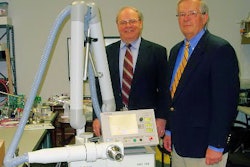The toxicity associated with radiation therapy for breast cancer is the focus of two new papers in the International Journal of Radiation, Oncology, Biology and Physics. In one, Philadelphia-based researchers tightened up the radiotherapy course length, partly in an effort to reduce skin toxicity. In the second, the authors investigated if radiation treatment increased the risk of cardiac toxicity.
From six to four weeks
One drawback of standard whole-breast radiation therapy after lumpectomy is the six- to seven-week treatment time, according to Dr. Gary Freedman and colleagues from the University of Pennsylvania. Intensity-modulated radiation therapy (IMRT) can shorten the treatment time and minimize dose inhomogeneities, but it does have its own issue of acute toxicity. Freedman's group tested an IMRT four-week protocol that included tumor bed boost.
The study included 75 women with histologically confirmed invasive or in situ breast carcinoma, treated with breast-conserving surgery. Among all the patients, 44% also had chemotherapy before radiation treatment.
For the IMRT technique, "the physician defined the clinical target volume as the palpable breast tissue anterior to the chest wall to within 5 mm of the skin, with a margin of 2 cm in the superior, inferior, and lateral directions," the authors explained. "Treatment energy was 6 or 10 MV depending on the patient chest wall separation" (IJROBP, June 1, 2007, Vol. 68:2, pp. 347-353).
The majority of patients (67%) had T1 tumors and 71% were stage N0. The histology was invasive ductal carcinoma in 76% of the cases. The median chest wall separation was 21 cm.
The entire breast was treated to 2.25 Gy per day for 20 fractions, for a total of 45 Gy. Using electrons, the boost was given at 2.8 Gy per fraction for 20 days, for a total of 56 Gy. Five fractions per week were given for four weeks.
The study's primary end point was acute skin toxicity. The Breast Cancer Treatment Outcome Scale (BCTOS) was used for patient self-assessment data on perceived aesthetics and function (pain, mobility) after treatment.
According to the results, the maximum skin toxicity by the end of treatment week four was grade 1 in 65% of the cases and grade 2 in 23%. By six weeks, all grade 2 skin toxicity had resolved. The authors found that the maximum skin toxicity varied by bra size with more cases of grade 1 and 2 toxicity experienced by those with larger breasts (D cup or 40 plus).
There were six adverse events after completion of radiotherapy: five cases of infection and one death, the latter due to distant metastases. Based on the BCTOS scale, the six-week mean post-treatment score was 1.67 (a score of 1-2 equaled no difference or mild difference compared to uninvolved breast).
"This radiation schedule is feasible and associated with low and acceptable acute toxicity, with no significant decrease in cosmesis and breast-related quality-of-life measures by six weeks," the authors concluded. "This radiation schedule may represent an alternative both to longer six-week to seven-week standard whole-breast radiation." The group said they would continue to follow these patients at six-month intervals for five years.
Heart health
Since the late 1960s, Dr. Luis Fajardo and Dr. James Stewart have analyzed radiation injury to the heart. In a 1973 paper, they suggested that radiotherapy might bring about ischemia by damaging the endothelial cells of the myocardial capillaries (Lab Investigation, August 1973, Vol. 29:2, pp. 244-257).
Since then, improved radiation therapy techniques and dosages have decreased the degree of cardiotoxicity. In addition, safeguards such as a clinical grading system for late cardiac effects have been established (IJROPB, March 30, 1995, Vol. 31:5, pp. 1205-1211).
Still, keeping tabs on radiation-induced cardiac risk factors is important. Dr. Dawn Hershman and colleagues from Columbia University, New York-Presbyterian Hospital in New York City and Saint Barnabas Medical Center in Livingston, NJ, did that by studying the long-term cardiac effects of radiotherapy in a population-based sample of elderly breast cancer patients.
For this retrospective analysis, the group looked at the records of 48,353 breast cancer patients, more than half of whom (55%) underwent mastectomy and 45% received adjuvant radiotherapy alone. In general, patients who had radiation therapy were younger, had cancer diagnosed in a later year, and had chemotherapy, the authors found.
They also noted that older patients, especially those with pre-existing heart disease, cardiovascular disease risk factors, or other comorbidities, were less likely to have radiation treatment.
Hershman's group found no significant association between radiotherapy and myocardial infarction or radiation treatment and myocardial infarction with ischemia. The presence of myocardial infarction (MI) was associated with age, African-American ethnicity, advanced stage, cardiac risk factors (CRFs), and heart disease.
"Although the presence of CRFs increased the likelihood of an MI, these factors did not increase the likelihood of RT-induced cardiac toxicity or left-sided cardiac toxicity," the group added (IJROPB, May 1, 2007, Vol. 68:1, pp. 82-93).
One result that surprised the authors was the lack of an association between myocardial infarction and postmastectomy radiation. "We believe that patients who receive RT postmastectomy might have higher radiation exposure to the myocardium than patients who receive RT postlumpectomy," they explained. "The lack of an association may reflect the high risk of breast cancer-related mortality among women who received postmastectomy RT."
They acknowledged that the study did have limitations, including a lack of information on radiation fields and dose schedules. But they noted that radiation techniques have evolved over the last few decades. Up until the 1990s, regional lymph nodes were irradiated, which would have increased exposure to the heart, they said. Now, 3D conformal radiation and IMRT techniques are used, which are more cardioprotective.
By Shalmali Pal
AuntMinnie.com staff writer
June 13, 2007
Related Reading
US-guided percutaneous placement of PBI balloon catheter is safe, efficient, November 30, 2006
Radiotherapy can benefit elderly women with early breast cancers, May 17, 2006
Skin condition after breast radiation requires clarification, March 6, 2006
Copyright © 2007 AuntMinnie.com



















